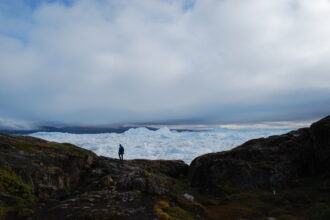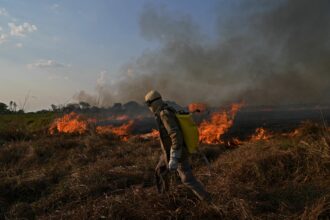The Biden administration gave final approval Monday to a major Arctic oil project, marking one of its most significant and controversial decisions on climate change and energy. The drilling project had become an important symbol for both environmentalists and the oil industry over the last year as each camp fought to bend the decision in its favor.
The administration paired the approval with an announcement that it would seek to expand or strengthen protections across 16 million acres in the Alaskan Arctic, both onshore and in coastal waters, restricting or prohibiting oil and gas drilling in those areas.
The Willow Project was proposed five years ago by ConocoPhillips and would be the largest oil development to proceed under the Biden administration. Over 30 years of production, it would pump about 576 million barrels of oil from a federally-managed reserve on Alaska’s North Slope. The site lies about 30 miles west of a village of 500 residents, most of whom are Alaska Natives, and partially within a protected area that is home to millions of migratory birds and a caribou herd that is a subsistence food source for the village.
While some environmental groups welcomed the new conservation measures announced by the administration, they roundly condemned Willow’s approval.
The new protections are “not nearly sufficient to blunt the impact of any version of the Willow oil and gas project,” said Karlin Itchoak, Alaska senior regional director for The Wilderness Society. “We cannot allow ConocoPhillips to accelerate the climate crisis, and in my mind that’s exactly what this does.”
Christy Goldfuss, chief policy impact officer at the Natural Resources Defense Council, said in a statement that the approval “is a grievous mistake. It green-lights a carbon bomb, sets back the climate fight and emboldens an industry hell-bent on destroying the planet. It’s wrong on climate and wrong for the country.”
For Biden, it was a politically fraught decision. Environmental groups fought hard to block Willow’s approval, and in the process motivated millions of young Americans to join a viral social media campaign to oppose the project. A petition on the website Change.org had drawn more than 3.2 million signatures as of Monday afternoon.
Advocates stressed that Biden had promised as a candidate that he would not approve any new drilling projects on public lands—Willow is located on the federally-managed National Petroleum Reserve-Alaska, or NPR-A. And they pointed to his broader climate goals to slash the nation’s climate pollution and reach “net-zero” emissions by 2050. The Willow Project, as planned, would continue to pump beyond that date.
But Biden felt immense pressure to approve the project, too. Alaska’s entire congressional delegation, including Sen. Lisa Murkowski, a Republican who has helped move the president’s nominations through the Senate, supported the project. The state legislature unanimously approved a resolution in favor.
Russia’s invasion of Ukraine further complicated the decision. After embargoes on Russian oil and gas sent energy prices soaring last year, Biden and other officials began appealing to oil companies to increase domestic production. Last week, as oil executives gathered for a major industry conference in Houston, they argued that rejecting Willow would be hypocritical.
“It’s exactly what this administration has been asking our industry to do,” said Ryan Lance, ConocoPhillips’ chief executive, referring to Willow during a panel at the conference. “It’s more production.”
The decision has also divided some Alaska Native communities. Leaders of the village of Nuiqsut, which is closest to the project, have been outspoken in their opposition to Willow, saying it threatened public health and subsistence hunting. Yet many other Native communities have supported the development.
“We’ve been working hard to get Willow to the finish line,” said Nagruk Harcharek, president of Voice of the Arctic Iñupiat, which represents local governments, Alaska Native Corporations and federally recognized tribes across the North Slope. Harcharek said the revenue generated by Willow—potentially billions of dollars—will support local communities and help them invest in wildlife monitoring and climate adaptation projects. “With today’s decision, we’re feeling pretty good.”

Representatives of Nuiqsut did not immediately respond to requests for comment.
Other Alaska Natives have warned about the impacts of oil drilling on their way of life. “The true cost of the Willow Project is to the land and to animals and people forced to breath[e] polluted air and drink polluted water,” said a statement issued Monday by Sovereign Iñupiat for a Living Arctic, a Native-led environmental group. “While out-of-state executives take in record profits, local residents are left to contend with the detrimental impacts of being surrounded by massive drilling operations.”
The final decision moderately limited the scope of Willow from what ConocoPhillips had proposed. As approved, the project could include up to 199 wells from three drilling sites, down from the five proposed by ConocoPhillips. The Interior Department, which manages the petroleum reserve, said the change would significantly reduce the water use and surface impacts of drilling. It would also reduce total oil production by about 8 percent, the decision said.
Willow would have peak output of about 180,000 barrels per day. The production and combustion of all that oil would release about 239 million metric tons of climate pollution over 30 years, the final decision said, roughly equal to running two coal-fired power plants over that period.
“This decision strikes a balance,” the document published by the department said, “allowing for development to occur in the NPR-A consistent with the terms of existing leases while at the same time requiring the implementation of robust protections for surface resources, as well as measures to limit greenhouse gas emissions and thereby reduce climate impacts.”
Supporters of the project have argued that, had the administration rejected Willow, other oil-producing countries would have made up the difference, pumping much or all of the petroleum that would have come from Willow. As a result, they argued, a rejection would not have a major impact on climate emissions.
Willow will surely have impacts locally. In early years of development, the project will require dozens of truck trips per hour during the winter and spring, according to the final environmental impact statement, polluting the area with diesel exhaust.
Some people in Nuiqsut have blamed an increase in the incidence of respiratory illness on nearby drilling—ConocoPhillips operates a separate project a few miles north of town, and a second one to the west. Willow would add a third, just beyond the existing site to the west.
Keep Environmental Journalism Alive
ICN provides award-winning climate coverage free of charge and advertising. We rely on donations from readers like you to keep going.
Donate NowElectricity for Willow would come from a new, 98 megawatt natural gas-fired power plant. All of this would occur in a region that is warming about twice as fast as the continental United States, so fast that some Arctic villages are being forced to relocate. That warming is thawing the region’s permafrost, and ConocoPhillips has said it will use subterranean chillers to help maintain the ice beneath its roads and other operations, in order to prevent them from collapsing.
One of the new drilling sites would be within the Teshekpuk Lake Special Area, a protected wilderness that surrounds the largest lake in Arctic Alaska. The area is a critical habitat for migratory birds, caribou and other animals. More than a dozen species of vulnerable birds nest, molt or rest near the lake each year, including tens of thousands of white-fronted and Brant geese, according to the Audubon Society.
In a statement on Monday, the Interior Department said it would propose a new rule that “will consider additional protections for the more than 13 million acres designated as Special Areas,” including Teshekpuk Lake, “in recognition of their importance to wildlife and subsistence uses.” The statement also said the administration would protect about 2.8 million acres of the Arctic Ocean, banning oil and gas drilling indefinitely. Paired with steps taken by the Obama administration, that would remove all federally-managed waters in the Arctic Ocean from possible drilling.
The new protections were welcomed by Itchoak, of the Wilderness Society. But he said they do not eliminate a major concern of environmentalists: That the Willow Project could open up even more areas of the petroleum reserve to new drilling. ConocoPhillips agreed to relinquish 68,000 acres of leased land close to Teshekpuk Lake, as part of Monday’s approval, but Itchoak said that would still leave the company with leases in other areas where it could propose additional projects in the future.
Willow was initially approved by the Trump administration, but a judge overturned that decision after environmentalists filed numerous lawsuits. Monday’s approval could also be headed to the courts, said Erik Grafe, an attorney with Earthjustice, an environmental law firm that was involved in the previous round of lawsuits against Willow.
“Litigation is very likely,” he said.












